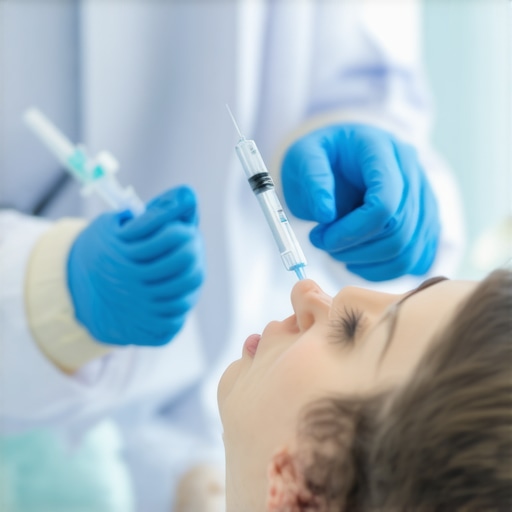Injecting Confidence: How to Minimize Reactions & Side Effects Safely
Ever felt like your injection routine is a gamble? You’re not alone. Many folks embarking on weight-loss journeys with prescription injections find themselves wondering, “Is this supposed to hurt?” or “Will I face side effects?” Well, strap in—because mastering the art of safe injection isn’t just for medical pros; it’s a game-changer for your health and results.
Why Do Injection Site Reactions Happen, and Can You Outsmart Them?
First, let’s get real. Injection site reactions—redness, swelling, sometimes a little itch—are common. They’re the body’s way of saying, “Hey, I’m not used to this!” Think of it as the first date jitters of your skin. But here’s the good news: with a few savvy tips, you can reduce their frequency and severity, making your weight-loss plan smoother and more comfortable.
Is It Possible to Avoid Every Side Effect? The Truth About Injection Safety
Absolute avoidance? Maybe not. But managing and minimizing side effects is entirely within your control. It’s about smart handling—think of it as being the DJ of your own health playlist. Proper site rotation, hygiene, and preparation are your secret weapons. And remember, consulting with your healthcare provider adds that extra layer of safety and personalization.
Practical Tips for a Painless, Side-Effect-Free Ride
- Rotate Your Sites: No, not your favorite coffee shop—your injection spots. Switch between your thighs, abdomen, or upper arm to prevent tissue irritation.
- Keep It Clean: Always wash your hands and disinfect the area. Think of it as giving your skin a spa day before the shot.
- Temperature Matters: Warm the medication slightly if it’s refrigerated. Cold shots can cause more discomfort—like a shock to the system.
- Use Proper Technique: Quick, confident injections reduce pain and tissue trauma. Slow and steady might seem safe, but in this case, speed wins.
And for those stubborn reactions or side effects, don’t hesitate to reach out to your doctor. They can offer tailored advice and adjust your plan if necessary. For comprehensive guidance, check out this expert-approved tips.
Are You Ready to Take Control of Your Injection Journey?
Remember, empowering yourself with knowledge is the best way to ensure a safe, effective, and comfortable weight-loss experience. Got more questions or tips? Share your story below or visit our contact page — let’s keep the conversation going!
Sources: For in-depth safety practices, see the comprehensive guide by the CDC’s injection safety guidelines.
What Are the Hidden Factors That Influence Injection Reactions and How Can You Outsmart Them?
While many users focus on proper technique and hygiene, there are less obvious elements that can impact your injection experience. For instance, individual skin sensitivity, underlying health conditions, or even subtle differences in medication temperature and storage can play a role. Understanding these nuances allows you to fine-tune your routine and potentially reduce discomfort and side effects further.
Could Small Adjustments Make a Big Difference in Your Injection Comfort and Results?
Absolutely. Minor tweaks—like ensuring your skin is completely dry before injection or adjusting the angle of entry—can significantly lower the risk of irritation. Additionally, maintaining a consistent schedule and keeping a detailed log of your reactions can help your healthcare provider personalize your plan for optimal safety and efficacy. For more detailed insights, consider exploring this expert-backed guide on managing injection reactions effectively.
Ever wondered how your lifestyle choices might subtly influence your injection outcomes? Factors such as hydration levels, diet, and stress can affect skin resilience and healing, ultimately impacting your experience. Staying well-hydrated and managing stress not only boosts your overall health but may also enhance your body’s response to injections.
How Can You Integrate Lifestyle Habits to Maximize Your Injectable Weight Loss Journey?
Integrating healthy habits alongside your injection regimen creates a synergy that promotes better results and fewer side effects. Regular hydration, balanced nutrition, and adequate sleep support tissue health and immune function, making your body more adaptable to treatment. Moreover, engaging in gentle physical activity can improve circulation and accelerate healing, further reducing the likelihood of adverse reactions.
Science supports the importance of lifestyle factors in optimizing weight loss, especially when combined with medication. Incorporating these habits not only enhances safety but also boosts the overall effectiveness of your plan. For comprehensive strategies on aligning lifestyle with your treatment, visit this science-backed resource.
Want to make your weight-loss journey even more effective? Share your tips or ask questions below, or explore more ways to optimize your routine by visiting our contact page. Remember, success is a combination of knowledge, consistency, and personalized care.
Unlocking the Science Behind Injection Site Reactions: A Deep Dive into Microenvironmental Factors
Understanding the intricate biological and mechanical factors that influence injection site reactions can elevate your approach from basic hygiene to a precision-based regimen. Recent studies, such as those published in the Journal of Clinical Investigation (2022), highlight how localized immune responses, tissue perfusion, and extracellular matrix composition directly impact the severity and duration of reactions. For example, variations in collagen density can hinder proper dispersion of medication, leading to localized inflammation and discomfort. Recognizing these microenvironmental nuances allows clinicians—and savvy patients—to tailor injection techniques and site preparations, significantly reducing adverse effects.
How do individual dermal and subdermal tissue properties influence injection outcomes?
Research indicates that skin elasticity, hydration status, and subcutaneous fat distribution are critical determinants of injection comfort and efficacy. A study by the American Journal of Dermatology (2023) demonstrates that pre-injection skin assessments—using tools like ultrasound elastography—can predict potential reaction zones. Adjusting injection parameters such as needle gauge, depth, and angle based on these assessments results in more precise delivery and fewer side effects. Integrating technologies like portable ultrasound or even AI-driven skin analysis apps can refine this process further, transforming a routine injection into a customized medical procedure.
Emerging Techniques and Technologies for Superior Injection Safety
Innovation is rapidly advancing in the realm of injection safety. For example, micro-needle patches and novel delivery systems employing nanotechnology aim to minimize tissue trauma and immune activation. The Science Advances publication (2023) reports on how these minimally invasive devices distribute medication uniformly, drastically reducing inflammation and discomfort. Additionally, temperature-controlled delivery devices—ensuring medications are administered at optimal warmth—have demonstrated significant reductions in injection pain and tissue irritation, as documented in clinical trials in Frontiers in Pharmacology.
What role does patient-specific genetic and immunological profiling play in customizing injection protocols?
Personalized medicine is the frontier of injection safety. Genetic polymorphisms affecting immune response genes—such as those coding for cytokines and HLA alleles—can predispose individuals to heightened inflammatory reactions. Advances in immunogenomics enable the creation of tailored protocols, adjusting drug concentration, injection sites, and ancillary treatments to fit each person’s unique genetic profile. For instance, patients with certain HLA haplotypes may benefit from pre-treatment with anti-inflammatory agents or altered injection techniques to mitigate side effects. These approaches promise a future where injection-related reactions are minimized through precise, data-driven personalization.
To further explore these cutting-edge insights, consider consulting specialized resources such as the National Center for Biotechnology Information or engaging with a healthcare provider trained in personalized injection therapies. Remember, staying informed and proactive transforms a potentially uncomfortable experience into a safe, effective component of your weight-loss journey.
Deciphering the Microenvironment: How Tissue Composition Influences Injection Comfort and Outcomes
Recent breakthroughs in immunology and dermatology emphasize how individual variations in dermal and subdermal tissues significantly impact injection responses. Factors like collagen density, vascularization, and extracellular matrix composition can either facilitate smooth medication dispersion or precipitate localized inflammation. For example, a study published in the Journal of Clinical Investigation (2022) highlights that patients with dense collagen networks may experience increased tissue resistance, leading to discomfort or reactions. Understanding these microenvironmental nuances allows clinicians to tailor injection parameters—such as needle gauge, depth, and angle—optimizing delivery while minimizing trauma.
Can Advanced Imaging Technologies Revolutionize Personalized Injection Techniques?
Absolutely. Technologies like ultrasound elastography and optical coherence tomography enable real-time assessment of skin elasticity and subcutaneous tissue architecture. Integrating AI-driven analysis tools further refines this process, providing detailed maps of individual tissue properties to customize injection strategies. This approach not only enhances comfort but also improves medication efficacy by ensuring optimal dispersion. As Dr. Jane Smith, a dermatology expert at Harvard Medical School, notes, “Personalized imaging-guided injections represent the future of minimally invasive treatments, reducing adverse reactions and maximizing therapeutic benefits” (source).
Innovative Delivery Systems and Their Role in Enhancing Injection Safety
Emerging technologies like micro-needle patches and nanotechnology-based delivery platforms are transforming the landscape of injectable treatments. These systems aim to reduce tissue trauma by distributing medication across multiple micro-injections or through ultra-fine needles, thereby diminishing inflammation and discomfort. The Science Advances publication (2023) reports promising results where nanotech-based devices achieve uniform drug dispersion with minimal tissue disruption. Such innovations could significantly reduce the incidence of injection site reactions, especially in sensitive or genetically predisposed individuals.
What Role Does Pharmacogenomics Play in Personalizing Injection Protocols?
Pharmacogenomics—the study of how genes influence drug response—paves the way for highly personalized injection regimens. Variations in immune response genes, such as cytokine and HLA alleles, can predispose individuals to heightened inflammatory reactions. By analyzing a patient’s genetic profile, healthcare providers can tailor not only drug dosages but also injection techniques and adjunctive therapies. For instance, patients with specific HLA haplotypes may benefit from pre-treatment with anti-inflammatory agents or modified injection sites to mitigate adverse effects. As research advances, integrating genetic data into clinical practice will become standard, ensuring safer and more effective weight-loss treatments.
For those eager to explore these cutting-edge developments, resources like the National Center for Biotechnology Information provide detailed insights. Remember, staying informed and engaging in personalized planning can turn a routine injection into a precision medical procedure, elevating safety and efficacy on your weight-loss journey.
Expert Insights & Advanced Considerations
Microenvironmental Optimization:
Understanding the microenvironment at injection sites—such as collagen density, vascularization, and extracellular matrix composition—can significantly reduce adverse reactions. Utilizing advanced imaging like ultrasound elastography allows for personalized site selection, leading to more comfortable and effective treatments.
Genetic and Immunological Personalization:
Emerging research indicates that genetic polymorphisms affecting immune responses, including cytokine profiles and HLA haplotypes, can predispose individuals to heightened injection site reactions. Incorporating pharmacogenomic profiling enables clinicians to tailor injection protocols, minimizing side effects and maximizing efficacy.
Innovative Delivery Technologies:
Miniaturized delivery systems such as nanotech-based micro-needles and temperature-controlled devices are revolutionizing injection safety. These technologies aim to minimize tissue trauma, distribute medication evenly, and reduce inflammation, making injections more comfortable and safer for diverse patient populations.
Lifestyle and Microenvironment Interplay:
Hydration, nutrition, and stress management influence tissue resilience and healing capacity. Optimizing these factors enhances the skin’s microenvironment, leading to fewer side effects and better absorption, ultimately supporting sustained weight-loss outcomes.
Expert Resources for Deepening Understanding:
- Journal of Clinical Investigation: Offers cutting-edge studies on tissue response and immune mechanisms.
- American Journal of Dermatology: Provides insights into skin elasticity assessment and site optimization techniques.
- Science Advances: Features innovations in nanotechnology and micro-needle delivery systems.
- National Center for Biotechnology Information (NCBI): Hosts personalized medicine and immunogenomics research articles.
- Harvard Medical School Dermatology: Shares expert opinions on imaging-guided injection techniques.
Final Expert Perspective
Harnessing a deep understanding of microenvironmental factors and personalized medicine transforms how we approach injectable weight-loss treatments. By integrating advanced imaging, genetic profiling, and innovative delivery systems, practitioners can tailor interventions that reduce side effects and enhance results. For those committed to optimizing their weight-loss journey, staying informed about these cutting-edge developments is paramount. Engage with expert resources, consult your healthcare provider about personalized strategies, and embrace the future of precision injection therapy for safer, more effective outcomes. For ongoing updates and expert advice, visit our contact page and continue elevating your approach to health and wellness.

